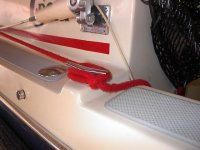Lori Ann":kf51qr5f said:
JamesTXSD":kf51qr5f said:
One thing that can help when docking singlehanded is to have one dockline that goes from the bow cleat, out around the bow pulpit, and led back to an aft cleat. With this, when you get off, you can have control of bow and stern with one hand. Drop that line over a cleat and you have a somewhat controlled boat and time to get other lines on.
Having difficulty visualizing this. Do you mean going from the bow cleat (in the middle of the bow) port to the aft end of the pulpit, around the front of the pulpit and down the starboard side to the cockpit (or vice-versa)?
Thanks,
Warren
Huh? :crook
Tie a long dock line to the bow cleat. Run it forward, just outside the bow pulpit (as in: to either side of the bow roller). Run it back to an aft cleat and tie it off. This gives you one line that runs nearly the length of the boat... tied off fore and aft, it can't get in the prop. With the line led nearly bow to stern, you have the "leverage" to easily pull in either end.
I don't singlehand that often, but when I do, I use this type of line for docking. If the wind is blowing the bow off, you can control that as soon as you step out of the cockpit (with line in hand).
It worked great with our trimaran, where there was a bit of a "sprint" from the helm, out of the cockpit, across the net, and to the dock. Not that different from the helm of our boats, through the cabin, and into the cockpit. Whew, I'm outta breath just from writing all that. :wink:
You can certainly run the line any ol' way you want from bow cleat to an aft cleat... I just find the physics of it better if it is outside the pulpit.
Since Joan handles lines while I run the helm, she usually steps off with fore and aft lines in hand, allowing her the same control. If it is really blowing us off the dock, I will put the bow on the dock (she is on the bow), she steps off and gets a line on
something; that gives me the control to pull the stern in with the motor, and I have a line ready in the cockpit. We do discuss what we plan to do each time we come in, so we both know what to expect.
Your mileage may vary. No eelgrass was harmed in the writing of this post. Void where prohibited by law. If you appear to be under 40, we may ask for ID. This forum's owners, families, heirs, and advertisers take no responsibility for the information contained in this post. :wink
Best wishes,
Jim

